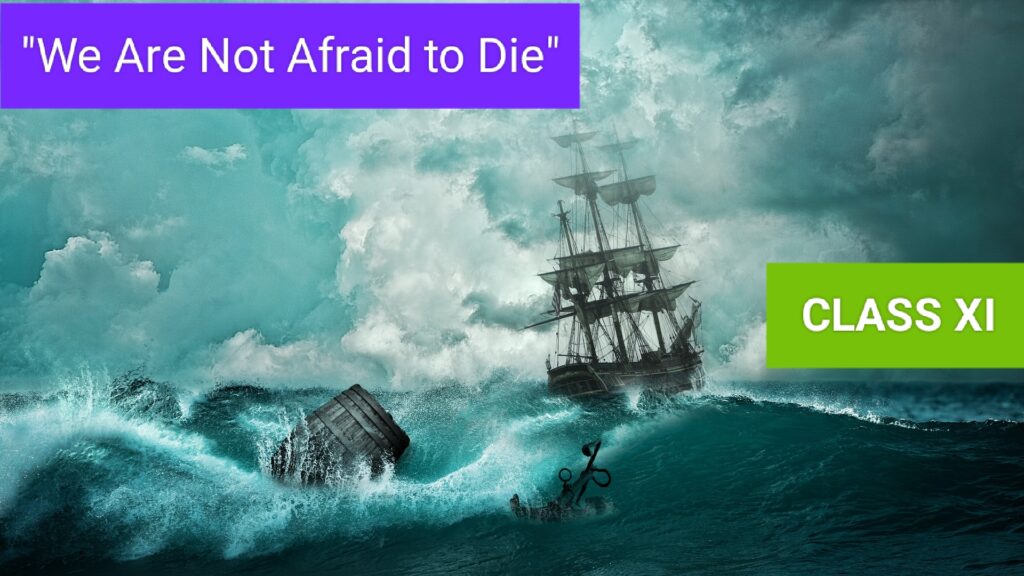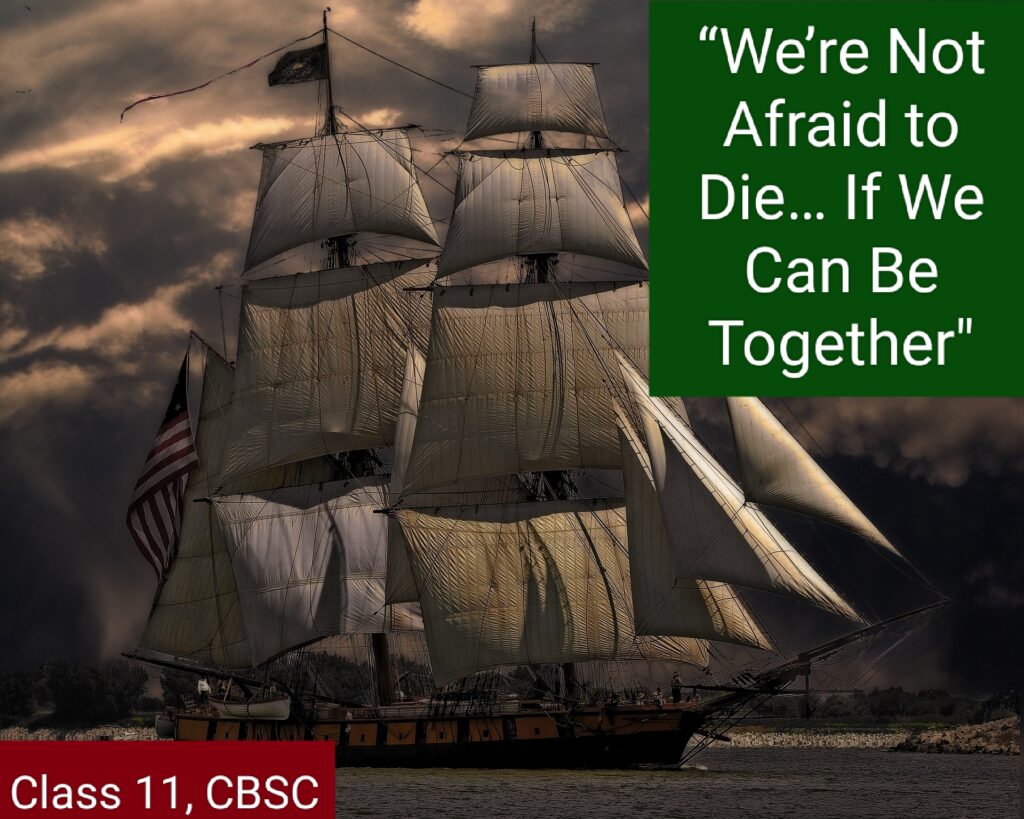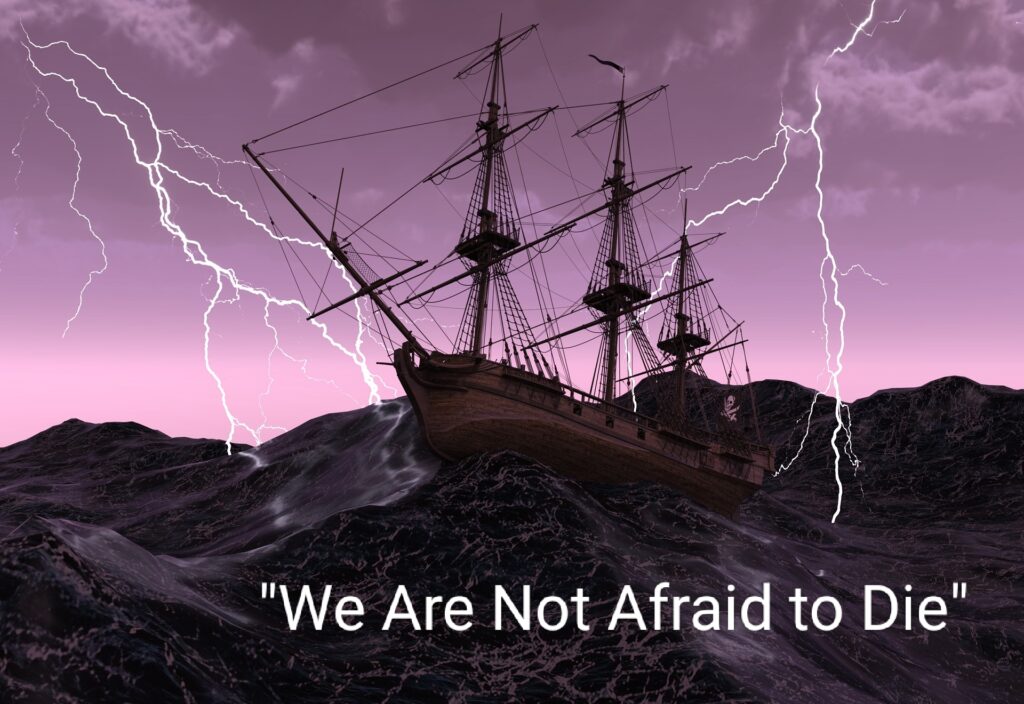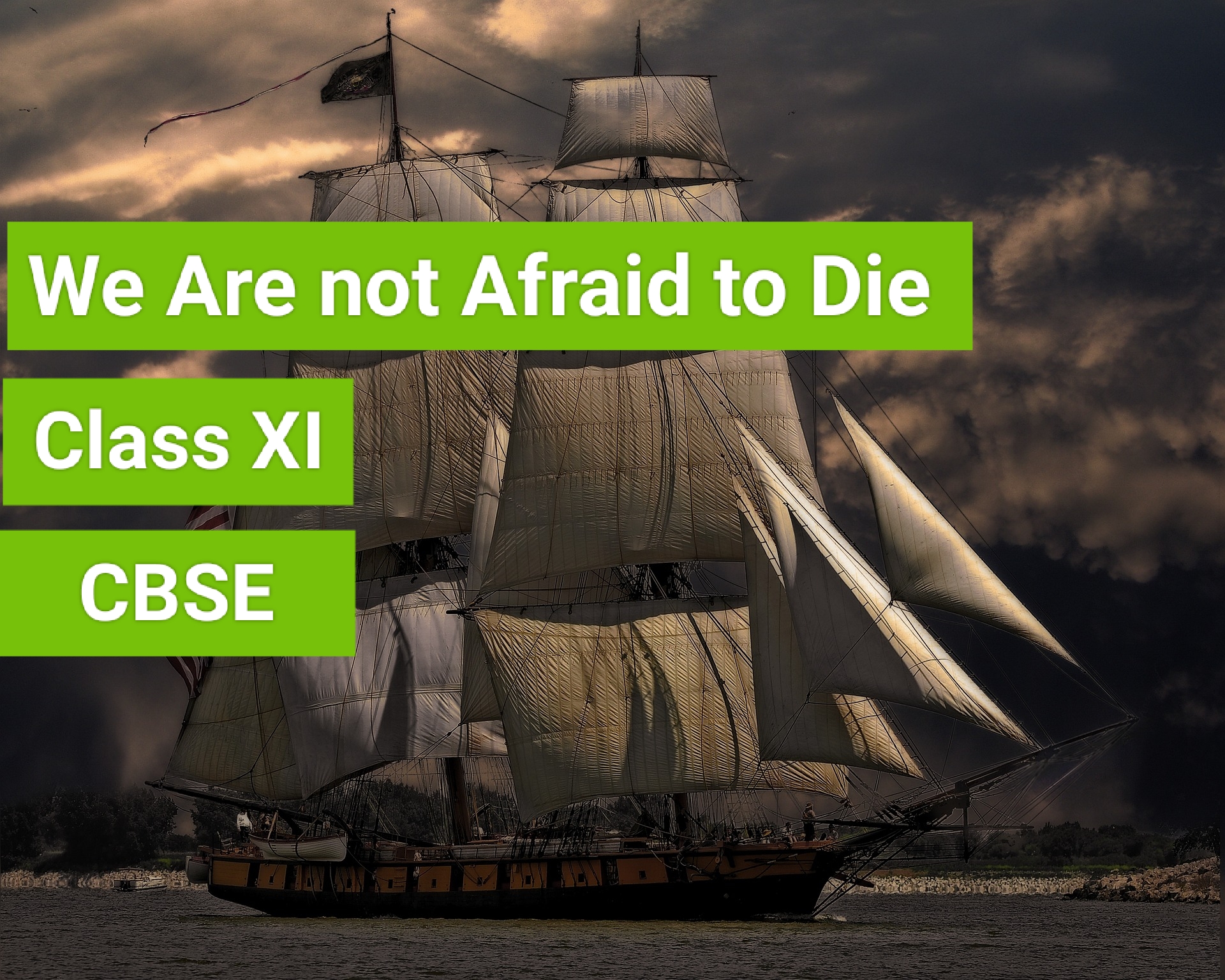“We’re Not Afraid to Die… If We Can Be Together” -Gordon Cook and Alan East

Summary
The story describes Gordon Cook’s extreme bravery and skill. The crew and family of Gordon Cook are engaged in an existential struggle with water and the waves. The author, his wife Mary, their son Jonathan, and daughter Suzanne set sail in July 1976 from Plymouth, England, to replicate Captain James Cook’s journey around the world 200 years earlier. They travelled with two sailors in their professionally designed ship, the Wavewalker. American Larry Vigil and Swiss Herb Sailor set out to conquer one of the world’s roughest oceans, the Southern Indian Ocean.
The first part of the journey—roughly 1,05,000 kilometers to Cape Town—went very smoothly. They began to encounter severe windstorms on the second day of their departure from Cape Town. The narrator was unaffected by the windstorms. However, the waves rose to fifteen meters above the mainmast, an alarming height. The writer’s ship reaches the southern Indian Ocean on December 25, approximately 3,500 kilometers to the east of Cape Town. On the ship, the family rang in the new year.
The waves were enormous as the morning of January 2nd approached. The sailors were forced to slow the ship down, remove the storm jib, and take a number of other precautions due to the unfavorable weather and massive waves. The sailors performed a life-raft drill, attached the lifeboats and life jackets, and the risk was so obvious. The Wavewalker was shaken unexpectedly at six o’clock by a huge explosion, and the writer was thrown overboard. Another massive wave struck the Wavewalker just as it was about to flip over, bringing it back to its original upright position. The writer’s head and ribs were slamming into the Wavewalker’s walls as he was thrown back onto the deck. The author took charge of the situation and decided to handle it on his own, despite numerous injuries. Larry and Herb began emptying the ship of water.
To prevent water from entering the ship, the author somehow managed to cover the canvas across the gaps. Additionally, both their electric pumps and their hand pumps failed simultaneously. The writer was fortunate to locate a functional spare electrical pump. All night, people were pumping, steering, fixing, and calling for help over the radio. The author looked at the charts and found that the French scientific base in Ile Amsterdam was their only hope.
Sue and Jon were severely hurt. However, if they were all together, they had no fear of dying. Sue had a serious injury and her head started to swell. In addition, the author became even more determined after witnessing his children’s bravery. They were finally able to feel the Ile Amsterdam. It was a volcanic island with 28 people waiting to welcome them.

Short Answer Type Questions
1.Identify the explorers who set sail for Australia from England.
Ans. The parents and their two children made up a small family of the narrator. A 37-year-old businessman(the narrator), his wife Mary, and their two children, a daughter named Sue and a son named Jonathan, made up the journey.
2. “We’re not afraid to die.” Who and when did say these things?
Ans. Jonathan, the six-year-old son of the narrator, made this comment as his father entered the room to comfort the children. But Daddy,” he continued, “we aren’t afraid of dying if we can all be together—you and mummy, Sue and I.”
3.How does the author describe Wavewalker? “
Ans. The boat of the narrator was given the name Wavewalker. It was built by professionals. It had a 30-ton wooden hull and measured 23 meters in length. The narrator spent months setting it up and putting it through its paces in the harshest conditions.
4. How did the narrator prepare for the long journey?
Ans. The narrator aspired to realize his childhood ambition of sailing the world as Captain James Cook. He worked on the project for 16 years and spent every spare moment perfecting his navigation skills. His Wavewalker, a boat 30 tons in weight and 23 meters long, was built by him.
5.Who were the two crew members that the narrator picked up? Which contribution did they make to this project?
Ans. The narrator made a very good and timely move in Cape Town. He hired two crew members, an American named Larry and a Swiss named Herb, to help them navigate the Southern Indian Ocean, which had the roughest seas in the world, before heading east. To remove the water, the crewmen put in a lot of effort. Even when they were directly confronted with death, they maintained their optimism and joy.
6. During his journey, how did the narrator observe Christmas and New Year’s Day?
Ans. Strong winds began to blow as the voyagers set sail from Cape Town and headed east. The bad weather continued for a few days. The family nevertheless celebrated Christmas despite the bad weather, complete with a Christmas tree. However, the weather appeared to remain unchanged throughout the New Year.
7.When did the family begin their expedition? What were their experiences along the way?
Ans. In July 1976, the voyagers left the English coast. The expedition was risky and difficult. It was clear to the author. It was known that the Southern Indian Ocean was very rough and stormy. After they left Cape Town, they had to deal with strong winds for several weeks. The boat was damaged when it came into contact with powerful waves on January 2. Death appeared inevitable.It was their hard work and good luck that they survived and reached the small island, named Ile Amsterdam.
8. The narrator’s knowledge of the Southern Indian Ocean was limited. Did his worries come to pass?
Ans. The Southern Indian Ocean, to the east of Cape Town, was extremely rough and dangerous, as the narrator was well aware. To assist him, he hired two crew members. They started to encounter strong gales as they left Cape Town, and it was true to his fears. For more than a week, they battled enormous winds and waves.
9. How did the narrator prepare for the turbulent sea on January 2?
Ans. The waves were enormous on January 2, in the early morning. Their boat soared to the top of each wave as it was struck by the wild wind. The narrator and his crew dropped the storm jib and tied a long mooring rope across the stern to slow the boat down. Then they tied everything down twice, donned oilskins and life jackets, and tied lifelines to themselves.
10. When the sea tossed the narrator and his daughter, what injuries did they sustain?
Ans. The narrator was tossed around the deck like a rag doll when the waves hit the boat. His left ribs were cracked, he had broken teeth, and his mouth was full of blood. However, he simply grabbed hold of the guardrails quickly and took control of the wheel. Sue, his daughter, sustained severe head injuries and her head swollen extremely after a while.
11. How did Sue attempt to brighten up the gloomy setting?
Ans : Sue made a funny card while she forgot about her swollen head and darkened eyes. It featured caricatures of Mary and the narrator on the front. She referred to them as amusing individuals who had made her laugh. There was also a message. It conveyed her affection, gratitude, and best wishes.
12. How did the narrator deal with the deck’s damage?
Ans. Mary was given control of the wheel by the narrator. He discovered canvas, screws, and a hammer. He fixed the canvas to the deck’s holes after spreading it out. As a result, he turned the water around to the side.
13. What additional issues with the pumps concerned the narrator?
Ans. The narrator discovered that the handpumps were clogged with debris after covering the deck’s open hole. The electric pump had gone off the rails. The storm had tossed the two spare handpumps overboard. He was fortunate to have another electric pump that could remove water.
14. How did young children contribute to the perilous voyage?
Ans. The narrator was married and had two children. He had a 7-year-old daughter Sue and a 6-year-old son Jon. Sue arm got cut and had a bump on her head. She didn’t, however, bother her father. They were starving for nearly two days. Jon told his father that he and Sue were not afraid to die if they were together, despite enduring ten days of gales and high waves that nearly sank their boat. The father was encouraged to fight the weather by their bravery and confidence in their parents.
15. In a situation where there was little hope, how did Sue manage to make her father laugh?
Ans. The parents were still tense and the situation was hopeless. Sue drew their caricatures for a card and referred to them as funny people. They laughed at her gesture. The card also expressed gratitude and optimism.

16. Reaching these isolated islands in the vast ocean was their only hope. Elaborate.
Ans. On the map, the narrator noticed two small islands. Ile Amsterdam, one of these, was a 65-kilometer-wide island in 1,50,000-kilometers of ocean. It was a French research facility. But it wasn’t easy to get to those tiny islands in the vast ocean, which were like pinheads.
17. What did the travelers accomplish on January 4?
Ans. On January 4, after 36 hours of continuous pumping, the narrator observed a significant drop in the water level. He set sail for the islands after raising the storm jib. They ate some beef and cracker biscuits for the first time in nearly two days.
18. When was the time when the narrator and his wife Mary were so close to losing all hope of survival?
Ans. On January 4, clouds began to form and the sea became rougher towards the afternoon. The couple had given up all hope of surviving by morning. The narrator and his wife Mary noticed that the broken planks were letting in more and more water that evening. Both of them felt like the end was very close.
19. What encouraging news did Jon and Sue deliver to their father on January 6 at six o’clock?
Ans. The narrator was taking a brief nap on January 6. Jonathan woke him up at six in the morning and asked to give him a hug “because he was the best father in the world, and the best captain” as well. After that, Sue informed them with joy that they had reached Ile Amsterdam.
20. Why did the narrator believe that Ile Amsterdam was the most beautiful island in the world?
Ans. The volcanic rock that made up Ile Amsterdam lacked any vegetation. However, the narrator and his crew considered it to be the world’s most beautiful island. They now felt safe, after all. They had finally reached land after escaping the Dead Sea.
21. How did the narrator respond to the words spoken by little Jon? What can we learn about his character from his actions?
Ans: He was unable to respond in the appropriate manner. However, he decided to use everything he had to fight the sea. He made the decision to put a stop to the ship and defend the weakened side. He used two 22-liter plastic paraffin barrels and an improvised anchor made of heavy nylon ropes to accomplish this. This demonstrates his inventiveness and determination.
22. When did Mary and the narrator sense that the end was near? Why did they think that way?
Ans: Mary and the narrator both had the feeling that the end was very close on January 5, 1977. Together, they sat, holding hands. Through the shattered planks, the ship’s movement brought in more and more water.
23. “Faith and courage help overcome obstacles.” How was the narrator able to successfully search the tiny island?
Ans:The narrator was looking for an island 65 kilometers in size in a 150,000-kilometer ocean. He worked optimistically on drift, current, wind speeds, and changes. He also used a sextant to figure out where they were.

Broad Answer Type Questions
- Comment on the adventure-filled expedition led by Gordon Cook and His Wife with a special focus on the title words.
Ans. The adventure story’s title “We Are Not Afraid to Die If we Can Be Together” is very moving. The narrator , his wife and his two children were the part of the journey. Jonathan, a young boy of six years old, is the one voyagers and Sue her sister also accompanied him in the journey. All of them were in trouble. They were close to admitting defeat. Death appeared to be imminent. There was a lot of water in the broken boat. However, the voyagers did everything in their power to save both the boat and themselves. Sue, the young daughter did not express any head pain. To expel water, the crewmen worked frantically. Jonathan stated that as long as they remained together, he did not fear death. An illustrious illustration of man’s bravery and optimism in the face of imminent death can be found in the story’s title. Willpower or human spirit frequently triumphs over danger. The mantra, “United we stand, divided we fall,” can be seen in the title. The indomitable spirit of men can overcome mountains, but only if they stand together.
- The lesson “optimism helps to endure direst stress” can be found in the story “We’re Not Afraid to Die.” Do you agree? why? or why not?
Answer:
“We’re Not Afraid to Die…” tells the true story of a man who overcame seemingly insurmountable odds to survive. It is a tale of bravery, perseverance, and hope. The Wavewalker was traveling around the world with the narrator, his wife, and their two children. They had bad weather in the Indian Ocean, and their boat was badly damaged. Despite being thrown overboard, the narrator was able to get back on the boat.
The children were also hurt. Despite the boat becoming flooded, no one gave up. The narrator tried to save the boat repeatedly. The youngsters trusted their father. Even though they pumped water out of the boat, more water came in. The storm’s fury subsided over time, but the boat was still leaking. The boat was able to be steered by the narrator 165 kilometers away in Amsterdam. Everyone on the boat, including the children, remained cheerful and hopeful throughout this ordeal. Nobody ever displayed despair. The narrator found strength in their optimism.
This is how it was the optimistic attitude of the family that help them to get out of the tremendous danger.
- “Although success is a rare commodity, it is achieved. A man can overcome even the impending disaster if he possesses certain qualities.” What factors determine success? Discuss with reference to the present text.
Ans. The seeds of success are planted in efforts. In general, success is the achievement of a goal. Success is possible with adequate resources, but it is contingent on both external and internal factors. We can’t control time, place, or opportunities, but we can develop our physical and mental capabilities. A body that isn’t lit physically hinders success. In the text all the family members were determined to get out of the danger and their seer determination and optimistic attitude finally let them out of the peril.
The next quality needed to accomplish the goal is intelligence. Another quality is mental health. We get a clear picture from it. Then comes stability and tenacity. We are granted the patience necessary to overcome obstacles by perseverance. Man needs to know how to control his senses and faculties and shouldn’t panic even when faced with impossible challenges. He will then find a way out. Even at the time of dire disaster, the family did not lost their mind and they tried to find a wayout and finally they reach an island and were saved.
Above all, a man should maintain his optimism and, if necessary, seek assistance from other trustworthy sources. Thus he can be successful in his journey of life.
Also read : “A Photograph” Questions and Answer, Class XI, CBSC


